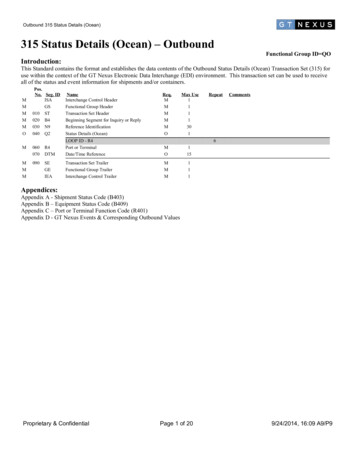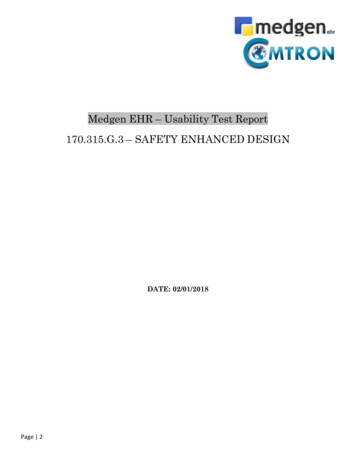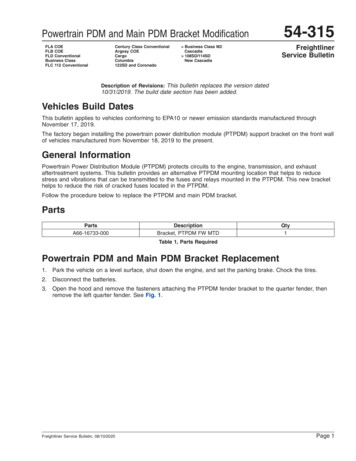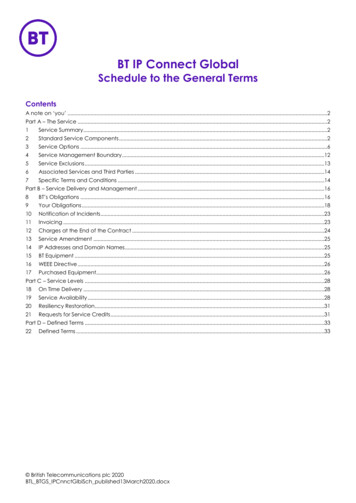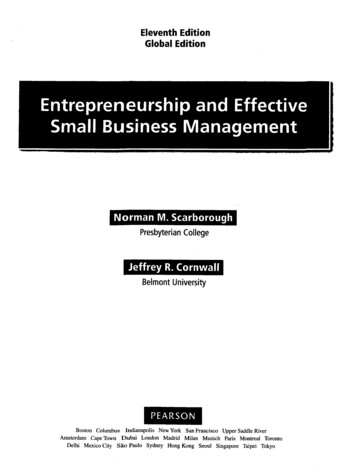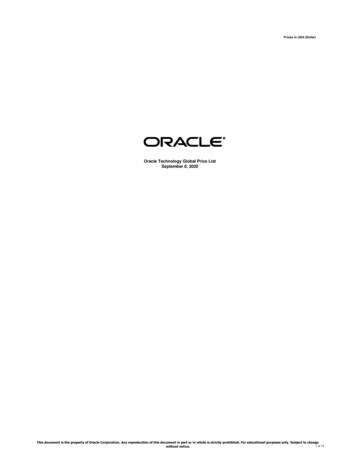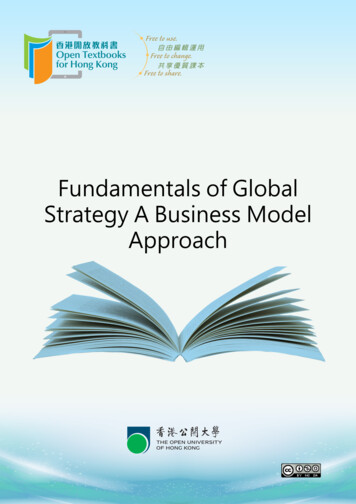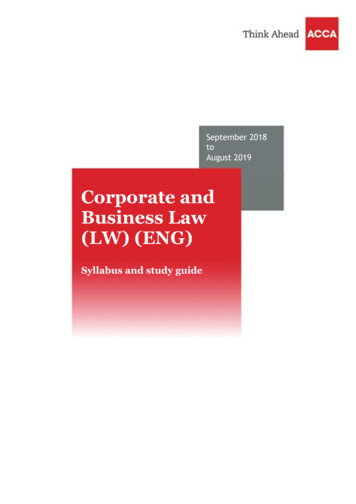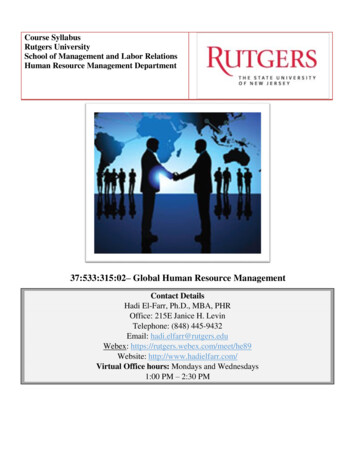
Transcription
Course SyllabusRutgers UniversitySchool of Management and Labor RelationsHuman Resource Management Department37:533:315:02– Global Human Resource ManagementContact DetailsHadi El-Farr, Ph.D., MBA, PHROffice: 215E Janice H. LevinTelephone: (848) 445-9432Email: hadi.elfarr@rutgers.eduWebex: https://rutgers.webex.com/meet/he89Website: http://www.hadielfarr.com/Virtual Office hours: Mondays and Wednesdays1:00 PM – 2:30 PM
Contents1. Course Description. 32. Course Details . 33. Readings . 44. Assessment . 4A. Attendance & Participation . 5B. Exams & Make-up Policy . 5C. Extra-credit Assignments . 5D. Paper& Presentation . 65. Polling Instructions . Error! Bookmark not defined.6. Course Requirements and Instructor Expectations . 67. Academic Honesty and Code of Conduct . 78. Attendance Policy . 79. Special Needs and Accommodation . 710. Tentative Course Schedule. 8
1. Course DescriptionThe trend of business internationalization has been exponentially increasing since the last century. This is demonstrated by the growthof the number of enterprises conducting business across the national borders of their headquarters, the amount of foreign directinvestment (FDI) and the value of trade between countries.Although it is hard to estimate, there are more than 82,000 multinational enterprises with more than 810,000 affiliates operatedworldwide. Those multinationals employ around 80 million. Moreover, in 2016, the global FDI reached 1.75 Trillion. The global FDIis projected to continue its growth over the coming years. Furthermore, in 2016, exports of merchandise and commercial services reachedaround 21 Trillion – around 27% of the World’s GDP. As a rough estimation, a total of 60-70% of the international trade takes placewithin the same multinational groups.Based on the preceding figures, organizations are internationalizing their operations aggressively – some are even being born as a globalenterprise. This trend has a direct impact on the HR function. HR professionals are expected to plan and manage a nationally andculturally diverse workforce. Moreover, they are expected to manage migrant workers and international assignees at each geographicallocation, in addition to its local employees.Therefore, this course aims at clarifying global HRM practices. To begin with, the course displays the drivers of businessinternationalization and the levels of corporate global integration. Then, the course outlines the structural alternatives for multinationalenterprises and the cultural/national and legal considerations to account for. Afterward, the course addresses strategic international HRMand the employment cycle within an international context.2. Course DetailsCourse Learning ObjectivesSMLR Learning ObjectivesThe aim of this course is to provide students with a robust understanding of international HRpractices and issues. In addition, the course targets building awareness and appreciation of theinternational business context and how HR can contribute as a strategic partner to enhancemultinational’s performance and competitive advantage. Students who successfully complete thiscourse should demonstrate an understanding of:1. Drivers for internationalization and the choices businesses have to organize their internationaloperations2. Various cultural, legal and labor relations contexts3. The impact of business internationalization on strategic HRM and its various functions,including HR planning, recruitment& selection, training& development, compensationmanagement, performance management, safety& health and employee relations. Research Skills – Demonstrate the ability to collect, analyze and synthesize information tomake logical and informed decisions impacting the workplace. Use evidence to evaluatehypotheses, theories and approaches to workplace issues. Employ current technologies to access information, to conduct research, and tocommunicate findings. Analyze and synthesize information and ideas from multiple sources to generate newinsights. Assess and critique relevant evidence and research findings. Access high-quality historical, qualitative, and quantitative evidence or research. Use evidence-based analysis to appraise the validity of various hypotheses, theories, andapproaches to workplace issues. Understanding Context - Evaluate the context of workplace issues, public policies, andmanagement decisions. Analyze the degree to which forms of human difference shape a person’s experience of,and perspectives on work. Analyze a contemporary global issue in their field from a multi-disciplinary perspective. Analyze issues related to business strategies, organizational structures, and work systems. Analyze issues of social justice related to work across local and global contexts (LSER). Analyze issues related to the selection, motivation, and development of talent in a globalcontext (HRM). Professional Development – Demonstrate an ability to interact with and influence others in aprofessional manner, and to effectively present ideas and recommendations. Develop effective presentation skills appropriate for different settings and audiences Develop career management skills to navigate one’s career. Understand cultural differences and how to work in a multicultural environment. Work productively in teams, on social networks, and on an individual basis. Develop cultural agility competencies.
37:533:315– Global Human Resource ManagementHuman Resource Management DepartmentSchool of Management and Labor RelationsTarget AudienceCourse Topics/Chapters Demonstrate lifelong personal & professional development skills.This course is an optimal learning experience for: Students aiming for a career in Human Resources. Students seeking knowledge of Global People Management. Managers seeking to improve their People Management skills and interested in implementingeffective Global HR practices. Employees involved in HR practices such as staffing and performance management within aglobal environment.1. The Internalization of HRM2. Strategic International HRM3. Design and Structure of the Multinational Enterprise4. International Mergers & Acquisitions, Joint Ventures and Alliances5. International HRM and Culture6. International Employment Law, Labor Standards and Ethics7. International Employee Relations8. International Workforce Planning and Staffing9. International Recruitment, Selection and Repatriation10. International Training and Management Development11. International Compensation, Benefits and Taxes12. International Employee Performance Management13. Well-Being of the International Workforce, and International HRIS14. Comparative IHRM: Operating in Other Regions and Countries3. Readings Tarique, I., Briscoe, D. and Schuler, R. (2016). International Human ResourceManagement: Policies and Practices for Multinational Enterprises. Fifth edition.London: RoutledgeISBN-13: 978-0415710534ISBN-10: 0415710537Link: https://www.routledge.com/products/9780415710534 Additional optional readings and useful links will be added as needed. They willbe available on the course’s Sakai website. , along with other course material.Please, make sure to check the course website frequently, so you won’t miss anyimportant material. Make sure to read all the assigned readings before attending classes in order tooptimize your learning experience.4. AssessmentThe assessment criteria abide by the Undergraduate Grades and Records Policy: http://catalogs.rutgers.edu/generated/nbug current/pg1358.html. Moreover, it is useful to read the New Brunswick Undergraduate Catalog in order to know your rights andobligations at: http://catalogs.rutgers.edu/generated/nb-ug current/pg1355.html. The following table lists the assessment methods andtheir weights:MethodPoints
37:533:315– Global Human Resource ManagementHuman Resource Management DepartmentSchool of Management and Labor Relations100100100100100500Forum DiscussionsMidterm OneMidterm TwoFinal ExamPaper & PresentationTotalThe following table lists the Grading and Point System assigned by the 35292-314 291Percent90-100%85-89%80-84%75-79%70-74%65-69% 64GradeAB BC ngGrade Points4.03.53.02.52.01.00.0A. Forum DiscussionsStudents are expected to actively participate in the online forum discussions, in order to interact, reflect, exchange ideas, and expandtheir knowledge base. There will be 5 forums in total. First, students should post an initial contribution that answers the forum question.The initial contribution should be posted during the first three days of the assigned week. The initial contribution will be assessed basedon its content, demonstrated analytical thinking and references used. Second, the student should actively collaborate and respond toother posts throughout the chapter’s week. At a minimum, the student should reply twice to others – in addition to the initial contribution.The collaboration will be assessed based on content and engagement, demonstrated analytical thinking and references used. In addition,the student will be assessed based on the quality of writing. The quality of writing will be assessed based on clarity and mechanics andorganization.B. Exams & Make-up PolicyThere are three noncumulative exams with equal weights (two midterms and one final). The exams consist of multiple-choice questions.Each exam covers the subjects addressed before its conduction (approximately each covers one-third of the material). The exam materialincludes the units’ lectures and the required readings. The exam dates are fixed and noted in the course schedule. Please note that allexams are closed-book, and you are not allowed to use any form of assistance. Please note that the exams will be monitored throughProctorTrack. You will receive a notification concerning ProctorTrack through an announcement posted early on during the semester.Make-up PolicyAgain, the dates for each of the three exams are noted on the course schedule. An exam grade of zero (0) will be assigned to any studentwho is absent without a legitimate excuse on the date of a regularly scheduled test. Legitimate excuses include illness requiring medicalattention (verified with a note from a doctor), an emergency situation (verified when applicable), or for a reason that is approved by theinstructor. The instructor’s approval should be attained at least two weeks before the exam date. Moreover, other reasons includeinclement weather (only when the Rutgers Information Service, 732-932-INFO, indicates that Rutgers is closed), and others as assignedby Rutgers Attendance Policy (please refer to the attendance policy section).An individual make-up exam will be held at a time that is convenient for the instructor. Individual make-up exams could be in the essay,short answers or multiple-choice questions formats – or any format chosen by the instructor.C. Extra-credit AssignmentsDuring the semester, you will have the opportunity to submit two assignments in order to improve the grades of the two midterm exams.Each assignment will contribute to up to 10 points. The two assignments are optional and will be in an essay format. Submission datesof both assignments will be the end of next week after the examination date. Late submissions are strictly not accepted. Assignmentsshould be both uploaded on the Sakai website and a hard copy submitted to the Teaching Aids.
37:533:315– Global Human Resource ManagementHuman Resource Management DepartmentSchool of Management and Labor RelationsD. Paper& PresentationProject Description & Performance GuidelinesThe course will provide an extensive overview of International HRM. However, when businesses internationalize, the HR professionalsshould familiarize themselves with the specific context of the targeted market. Those projects aim to familiarize students with variousnational contexts from different regions, thus further broadening the course content. Moreover, the project aims to strengthen yourteamwork, presentation, analytical and written communication skills.Students will have the opportunity to self-select each other and form teams. More so, each team will have the freedom to choose onenational context from the below-mentioned countries. However, if you fail to find a team or choose a case study by the time limitassigned to the course schedule, then the instructor will select a team to join on your behalf.Each group is formed of 6 to 8 students. Each team will be covering one distinctive country, thus no two or more teams will be allowedto cover the same case study. Therefore, the sooner you decide on the country, the more likely it will be assigned to you. The followingis the list of countries/case studies:I.II.III.IV.V.VI.Western Europe: Germany, Italy, Netherlands, United KingdomScandinavia: Denmark, Finland, SwedenCentral & Eastern Europe: Bulgaria, Poland, RussiaMediterranean, Middle East, and Africa: Ghana, Uganda, United Arab EmiratesAsia and the Pacific Rim: China, India, Indonesia, SingaporeAmerica: Canada, Chile, MexicoThe project consists of a paper and presentation. The paper size should not exceed 4000 words and the presentation-time is 14 minutes( 2 minutes for discussion). Both should cover the following:1. Overview of the country (750 words).This section provides a comprehensive and concise overview of the country. The aim of this section is to provide informationthat will support other sections in the report. This section might include information on the country’s geography & government,history, demographics, economic condition and sectors etc. A good source of information as a start would be the World FactBook: -factbook/2. Overview of the country’s national culture (1000 words).This section needs to debate the cultural dimensions of the country and compare them to the USA. Also, it needs to address thevarious cultural layers of the country. A good source to start with is ountries/.3. Overview of the business climate (including what makes this country favorable to do business at? What makes this countryunfavorable to do business at? What interesting things we should know about when conducting business in this country/business cultureand etiquette?) (1000 words).4. HR-specific challenges that a multinational might face when conducting business in this country? The HR challenges should be veryspecific to the country, and NOT general HR global issues (1000 words). At least 5 challenges should be debated and well developed,if not more.Note 01: you have 250 words that are flexible to use in any section.Note 02: the word limit does not apply to the reference list.Note 03: Keep the report specific to the country and support your claims with data and references.Important Notice: Group Projects are subject to peer assessment, and if a student does not contributeequally to a project compared to other group members, then the student may receive reduced or nopoints for the project grade.5. Technical Requirements1.2.3.4.5.Broadband connection with a reliable internet accessVoice input (Microphone) and output hardwareA webcam (800 x 600 resolution or better)Operating System (Windows 7, 8, or higher / MAC OSX 10.7 Lion or higher)Microsoft Word & PowerPoint
37:533:315– Global Human Resource ManagementHuman Resource Management DepartmentSchool of Management and Labor Relations6.7.8.9.10.Adobe Flash – latest version (Links to an external site.) (you will need it to view videos)Adobe Reader (PDF reader)A Media PlayerBasic computer requirements for CanvasLinks to an external site.Proctortrack technical requirements6. Academic Honesty and Code of ConductStudents are expected to abide by Rutgers’s Academic Integrity Policy and Code of Student Conduct. Acts of cheating, plagiarism,forgery, fabrication or misrepresentation are not tolerated and will be dealt with according to university policies and procedures. If youhave doubts concerning committing a potential act of academic dishonesty, please contact the course instructor for advice. Moreover,you are advised to check the websites of the Office of Academic Integrity at: http://academicintegrity.rutgers.edu/ and the Office ofStudent Conduct at: http://studentconduct.rutgers.edu/. Alternatively, you can refer to the undergraduate catalog section for academicintegrity at: http://catalogs.rutgers.edu/generated/nb-ug current/pg1370.html and the section for Code of Conduct at:http://catalogs.rutgers.edu/generated/nb-ug current/pg1373.html.7. Attendance PolicyAttendance at all scheduled classes shall be expected. Failure to attend classes with no authentic excuse will negatively affect your grade– as attendance and participation are accounted for in the course assessment. Rutgers University Attendance Policy has assigned thefollowing recognized grounds for absences:Rutgers University Attendance Policy has assigned the following recognized grounds for absences:1. Illness requiring medical attention (written proof is needed).2. Curricular or extracurricular activities approved by the faculty.3. Personal obligations claimed by the student and recognized as valid (pre-approved by the instructor unless it is a familyemergency).4. Recognized religious holidays (please refer to the links at the end of this section).5. Severe inclement weather causing dangerous traveling conditions (Rutgers University usually cancels classes when the weatherconditions are not safe for commute) – this condition is invalid as the course is delivered online and requires no transportation.As a general guideline, students have to attain the instructor’s approval before their absence unless it is an emergency. At least twoweeks’ notice is required before any examination date. If the cause of absenteeism is legitimate, then the instructor w
Rutgers University School of Management and Labor Relations . a total of 60-70% of the international trade takes place within the same multinational groups. Based on the preceding figures, organizations are internationalizing their operations aggressively – some are even being born
